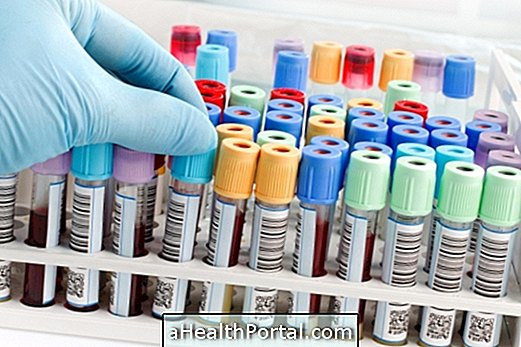Polaramine is an antiallergic antihistamine that works by blocking the effects of histamine on the body, a substance responsible for allergy symptoms such as itching, hives, redness of the skin, swelling in the mouth, itchy nose or sneezing, for example. Learn about other allergy symptoms.
This medicine is available in pharmacies, with the trade name Polaramine or in the generic form with the name dexchlorpheniramine maleate or with similar names Histamin, Polaryn, Fenirax or Alergomine, for example.
Polaramine can be purchased in the form of tablets, pills, drops solution, syrup, dermatological cream or ampoules for injection. Tablets and pills can only be used by people over 12 years of age. The drops solution, the syrup and the dermatological cream, can be used from 2 years of age.

What is it for
Polaramine is indicated for the treatment of allergies, itching, runny nose, sneezing, insect bites, allergic conjunctivitis, atopic dermatitis and allergic eczema, for example.
How to take
The use of Polaramine varies according to the presentation. In the case of tablets, pills, drops or syrup, it should be taken orally and the dermatological cream should be used directly on the skin.
In the case of a pill, pill, drops solution or oral solution, if you forget to take a dose at the right time, take it as soon as you remember and then readjust the times according to this last dose, continuing the treatment according to the new schedules. Do not double the dose to make up for a forgotten dose.
1. 2mg tablets
Polaramine in the form of tablets is found in a packaging with 20 tablets and should be taken with a glass of water, before or after feeding and, for a better action of Polaramine, do not chew and do not break the tablet.
Adults and children over 12 years: 1 tablet 3 to 4 times a day. Do not exceed the maximum dose of 12mg / day, that is, 6 tablets / day.
2. 6mg pills
Polaramine Repetab tablets should be taken whole, without breaking, without chewing and with a full glass of water, because it contains a coating so that the medicine is released slowly in the body and has a longer duration of action. Polaramine Repetab is sold in pharmacies with 12 pills.
Adults and children over 12 years: 1 pill in the morning and another at bedtime. In certain more resistant cases, it may be recommended by the doctor to administer 1 pill every 12 hours, without exceeding the maximum dose of 12 mg, two tablets, in 24 hours.

3. 2.8mg / mL drops solution
Polaramine drops solution is found in pharmacies in bottles of 20mL and should be taken orally, the dose depending on the person's age:
Adults and children over 12 years: 20 drops, three to four times a day. Do not exceed the maximum dose of 12 mg / day, that is, 120 drops / day.
Children aged 6 to 12: 10 drops or 1 drop for every 2 kg of weight, three times a day. A maximum of 6 mg daily, that is, 60 drops / day.
Children aged 2 to 6 years: 5 drops or 1 drop for every 2 kg of weight, three times a day. A maximum of 3 mg daily, ie 30 drops / day.
4. 0.4mg / mL syrup
Polaramine syrup is sold in bottles of 120mL, it must be taken using the doser that comes in the package and the dose depends on the person's age:
Adults and children over 12 years old: 5 mL 3 to 4 times a day. Do not exceed the maximum dose of 12 mg / day, that is, 30 mL / day.
Children aged 6 to 12 years: 2.5 mL three times a day. A maximum of 6 mg daily, that is, 15 mL / day.
Children aged 2 to 6 years: 1.25 mL three times a day. A maximum of 3 mg daily, ie 7.5 mL / day.
5. Dermatological cream 10mg / g
Polaramine dermatological cream is sold in a 30g tube and should only be applied externally on the skin, in the affected area twice a day and it is recommended not to cover the area being treated.
This cream should not be applied to the eyes, mouth, nose, genitals or other mucous membranes and should not be used on large areas of skin, especially in children. In addition, Polaramine dermatological cream should not be applied to areas of the skin that have blisters, that are bruised or that have secretion, around the eyes, genitals or on other mucous membranes.
Exposure to sunlight of the areas treated with Polaramine dermatological cream should be avoided, as undesirable skin reactions may occur and, in case of reactions such as burning, rashes, irritations or if there is no improvement in the condition, stop the treatment immediately.
6. Ampoules for injection 5 mg / mL
Polaramine ampoules for injection must be administered intramuscularly or directly into the vein and are not indicated for use in children.
Adults: IV / IM. Make a 5 mg injection, without exceeding the maximum daily dose of 20 mg.

Possible side effects
Some of the most common side effects that may occur during treatment with Polaramine are drowsiness, tiredness, dizziness, headache, dry mouth or difficulty urinating. For this reason, care should be taken or avoid activities such as driving, using heavy machinery or performing dangerous activities. In addition, the use of alcohol can increase the effects of drowsiness and dizziness if consumed at the same time as being treated with Polaramine, therefore, it is important to avoid the consumption of alcoholic beverages.
It is advisable to discontinue use and seek medical help immediately or the nearest emergency department if symptoms of allergy to Polaramine appear, such as difficulty in breathing, a feeling of tightness in the throat, swelling in the mouth, tongue or face, or hives. Learn more about symptoms of anaphylaxis.
Immediate medical attention should also be sought if Polaramine is taken in higher than recommended doses and symptoms of overdose such as mental confusion, weakness, ringing in the ears, blurred vision, dilated pupils, dry mouth, redness of the face, fever, tremors, insomnia, hallucinations or fainting.
Who should not use
Polaramine should not be used in premature infants, newborns, breastfeeding women, or in people using oxidized monoamine (MAOI) inhibitors, such as isocarboxazide (Marplan), phenelzine (Nardil) or tranylcypromine (Parnate).
In addition, Polaramine can interact with:
- Anxiety medications like alprazolam, diazepam, chlordiazepoxide;
- Depression medications such as amitriptyline, doxepine, nortriptyline, fluoxetine, sertraline or paroxetine.
It is important to inform the doctor and pharmacist of all medications that are used to prevent a decrease or increase in the effect of Polaramine.
Was this information helpful?
Yes No
Your opinion is important! Write here how we can improve our text:
Any questions? Click here to be answered.
Email in which you want to receive a reply:
Check the confirmation email we sent you.
Your name:
Reason for visit:
--- Choose your reason --- DiseaseLive betterHelp another personGain knowledge
Are you a health professional?
NoMedicalPharmaceuticalsNurseNutritionistBiomedicalPhysiotherapistBeauticianOther
Bibliography
- DRUGS.COM. Dexchlorpheniramine Information from Drugs.com. Available in: . Accessed on 13 Oct 2020
- ANVISA. ANVISA electronic file. Available in: . Accessed on 13 Oct 2020
.png)


.jpg)








.jpg)






